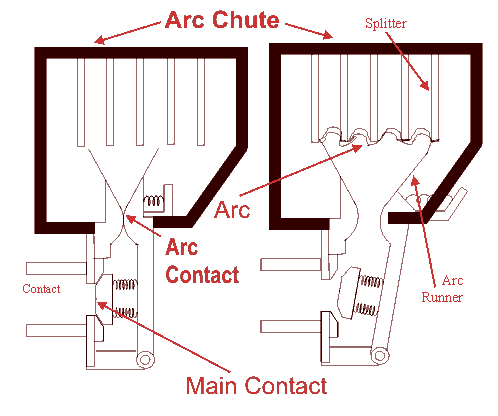This type of circuit breakers is those kinds of circuit breaker which operates in the air at atmospheric pressure. After the development of oil circuit breaker, the medium voltage air circuit breaker (ACB) is replaced completely by oil circuit breaker in different countries. But in countries like France and Italy, ACBs are still preferable choice up to voltage 15 KV. It is also good choice to avoid the risk of an oil fire, in case of oil circuit breaker. In America, ACBs were exclusively used for the system up to 15 KV until the development of new vacuum and SF6 circuit breakers.
Types of ACB
There are mainly two types of ACB are available.
1) Plain air circuit breaker.
2) Air Blast Circuit Breaker.
Working Principle of Air Circuit Breaker
The working principle of this breaker is rather different from those in any other types of circuit breakers. The main aim of all kind of circuit breaker is to prevent the reestablishment of arcing after current zero by creating a situation wherein the contact gap will withstand the system recovery voltage. The air circuit breaker does the same but in a different manner. For interrupting arc it creates an arc voltage in excess of the supply voltage. Arc voltage is defined as the minimum voltage required maintaining the arc. This circuit breaker increases the arc voltage by mainly three different ways,
- It may increase the arc voltage by cooling the arc plasma. As the temperature of arc plasma is decreased, the mobility of the particle in arc plasma is reduced; hence more voltage gradient is required to maintain the arc.
- It may increase the arc voltage by lengthening the arc path. As the length of arc path is increased, the resistance of the path is increased, and hence to maintain the same arc current more voltage is required to be applied across the arc path. That means arc voltage is increased.
- Splitting up the arc into a number of series arcs also increases the arc voltage.
Operation of ACB
- The first objective is usually achieved by forcing the arc into contact with as large an area as possible of insulating material. Every air circuit breaker is fitted with a chamber surrounding the contact. This chamber is called ‘arc chute’. The arc is driven into it. If the inside of the arc chute is suitably shaped, and if the arc can be made conform to the shape, the arc chute wall will help to achieve cooling. This type of arc chute should be made from some kind of refractory material. High-temperature plastics reinforced with glass fiber and ceramics are preferable materials for making arc chute.
- The second objective that is lengthening the arc path, is achieved concurrently with fist objective. If the inner walls of the arc chute is shaped in such a way that the arc is not only forced into close proximity with it but also driven into a serpentine channel projected on the arc chute wall. The lengthening of the arc path increases the arc resistance.
- The third technique is achieved by using metal arc slitter inside the arc chute. The main arc chute is divided into numbers of small compartments by using metallic separation plates. These metallic separation plates are actually the arc splitters and each of the small compartments behaves as individual mini-arc chute. In this system, the initial arc is split into a number of series arcs, each of which will have its own mini-arc chute. So each of the split arcs has its own cooling and lengthening effect due to its own mini-arc chute and hence individual split arc voltage becomes high. These collectively, make the overall arc voltage, much higher than the system voltage.
This was working principle of air circuit breaker now we will discuss in details the operation of ACB in practice.
The air circuit breaker, operated within the voltage level 1 KV, does not require any arc control device. Mainly for heavy fault current on low voltages (low voltage level above 1 KV) ABCs with appropriate arc control device, are a good choice. These breakers normally have two pairs of contacts. The main pair of contacts carries the current at normal load and these contacts are made of copper. The additional pair is the arcing contact and is made of carbon. When the circuit breaker is being opened, the main contacts open first and during the opening of main contacts the arcing contacts are still in touch with each other. As the current gets, a parallel low resistive path through the arcing contact during the opening of main contacts, there will not be any arcing in the main contact. The arcing is only initiated when finally the arcing contacts are separated. The each of the arc contacts is fitted with an arc runner which helps, the arc discharge to move upward due to both thermal and electromagnetic effects as shown in the figure. As the arc is driven upward it enters in the arc chute, consisting of splitters. The arc in chute will become colder, lengthen and split hence arc voltage becomes much larger than system voltage at the time of operation of air circuit breaker, and therefore the arc is quenched finally during the current zero.
Although these types of circuit breakers have become obsolete for medium voltage application, they are still a preferable choice for high current rating in low voltage application.






